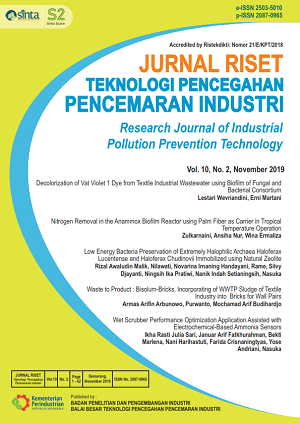Wet Scrubber Performance Optimization Application Assisted with Electrochemical-Based Ammonia Sensors
DOI:
https://doi.org/10.21771/jrtppi.2019.v10.no2.p36-42Keywords:
crumb rubber, ammonia, wet scrubber, electrochemical sensorAbstract
Crumb rubber is one of Indonesia’s agroindustry export commodities. This industry faces environmental problems due to their wastes, both liquid and air. The source of air pollution is commonly from drying process that emitted odor from its evaporation and heating phenomena. Industry uses wet scrubber technology as air pollution control from emitted odor from drying process. Preliminary identification in noncontrolled wet scrubber shown that wet scrubber efficiency around 47%. Low efficiency wet scrubbing process causes rain drop of water vapor around drying process. This research used electrochemical based sensor MICS 5524 as ammonia monitoring instrument, assisted with arduino as microcontroller to regulate water discharge through valve controlling scrubbing process. This electrochemical based sensor reads ammonia based on voltage reads by Arduino microcontroller. Ammonia reading then control scrubbing process by adjusting valve opening for spray water distribution. Wet scrubber efficiency increases to 66,96% due to water scrubbing control, also can save water utilization as high as 61,90%, followed by absence of rain drop contains ammonia around drying process area.References
C. Barlow, “The natural rubber industry,” Outlook Agric., vol. 12, no. 1, pp. 2–11, Mar. 1983.
T. . Utomo, U. Hasanudin, and E. Suroso, “World Congress on Engineering : WCE 2010 : 30 June - 2 July, 2010, Imperial College London, London, U.K.,” in Proceedings of the World Congress on Engineering 2010, 2010, p. 1665.
T. P. Utomo, U. Hasanudin, and E. Suroso, “Comparative Study of Low and High-Grade Crumb Rubber Processing Energy,” in Proceedings of World Congress on Engineering , 2010.
S. Maulina, N. Meriam Nik Sulaiman, and N. Zalina Mahmood, “Enhancement of Eco-Efficiency Through Life Cycle Assessment in Crumb Rubber Processing,” Procedia-Social Behav. Sci., vol. 195, pp. 2475–2484, 2015.
D. Setyamidjaja, KARET. Yogyakarta: Penerbit Kanisius (Anggota IKAPI), 1993.
Y. Andriani, I. Rasti, J. Sari, J. A. Fatkhurrahman, and N. Harihastuti, “Potensi Cemaran Lingkungan Di Industri Karet Alam Crumb Rubber,” Pros. SNPBS (Seminar Nas. Pendidik. Biol. dan Saintek) Ke-4, pp. 445–451, 2019.
H. I. Atagana*, B. O. Ejechi, and A. M. Ayilumo, “Fungi Associated with Degradation of Wastes from Rubber Processing Industry,” Environ. Monit. Assess., vol. 55, no. 3, pp. 401–408, 1999.
G. Hutter, “Reference Data Sheet on Air Pollution Control Devices,” Researchgate, Aug-1997. .
US EPA, “Monitoring by Control Technique - Wet Scrubber For Particulate Matter.” .
J. A. Fatkhurrahman, I. R. J. Sari, and N. Zen, “Low cost particulate sensor sebagai unit kontrol untuk meningkatkan efisiensi penggunaan air proses wet scrubber,” J. Ris. Teknol. Pencegah. Pencemaran Ind., vol. 8, no. 1, p. 35, May 2017.
S. H. Byeon, B. K. Lee, and B. Raj Mohan, “Removal of ammonia and particulate matter using a modified turbulent wet scrubbing system,” Sep. Purif. Technol., vol. 98, pp. 221–229, 2012.
A. Bhargava, “Wet Scrubbers – Design of Spray Tower to Control Air Pollutants,” Int. J. Environ. Planning and Dev., vol. 1, no. 1, pp. 36–41, Sep. 2017.
C.-L. Chien, C.-J. Tsai, S.-R. Sheu, Y.-H. Cheng, and A. M. Starik, “High-efficiency parallel-plate wet scrubber (PPWS) for soluble gas removal,” Sep. Purif. Technol., vol. 142, pp. 189–195, Mar. 2015.
Dong Dong, T. J. McAvoy, and L. J. Chang, “Emission monitoring using multivariate soft sensors,” in Proceedings of 1995 American Control Conference - ACC’95, vol. 1, pp. 761–765.
I. C. Jeong, G. Li, and S. B. Lim, “Sensor-based Emissions Monitoring System,” in 6th International Conference on New Trends in Information Science, Service Science and Data Mining (NISS, ICMIA and NASNIT),25 2012, 2012.
O. A. M. Popoola et al., “Use of networks of low cost air quality sensors to quantify air quality in urban settings,” Atmos. Environ., vol. 194, pp. 58–70, Dec. 2018.
S. Munir, M. Mayfield, D. Coca, S. A. Jubb, and O. Osammor, “Analysing the performance of low-cost air quality sensors, their drivers, relative benefits and calibration in cities-a case study in Sheffield.,” Environ. Monit. Assess., vol. 191, no. 2, p. 94, Jan. 2019.
Downloads
Published
How to Cite
Issue
Section
License
Copyright (c) 2019 Ikha Rasti Julia Sari, Januar Arif Fatkhurrahman, Bekti Marlena, Nani Harihastuti, Farida Crisnaningtyas, Yose Andriani, Nasuka Nasuka

This work is licensed under a Creative Commons Attribution-NonCommercial-ShareAlike 4.0 International License.











